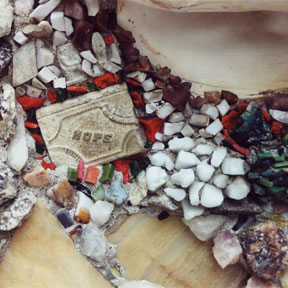
Patriotism Shrine
Using the same materials and visual vocabulary as the nearby religious grottoes, the Patriotism Shrine features several saints of American History. Like the Grotto of Christ the King, a curved wall gradually becomes higher in its center to spotlight a statue of Christopher Columbus in a niche-like arch. Gold mosaic tiles spell out his name with a cross and anchor and the title: "Discoverer of America 1492." All around are seashells and blue glass representing the sea voyage from Old World to New. Other heroic statues of the shrine represent George Washington next to a sculpted bell marked "Liberty 1776" and Abraham Lincoln next to a sculpted bell marked "Unity 1865". In the center of the plaza, sheltered by the surrounding wall, is a three-tiered fountain topped by a stone eagle spreading its wings, representing the United States.

Despite the overt nationalistic symbolism of the Patriotism Shrine, instead of standing back in lowly admiration of these heroic figures, we are drawn in toward the shrine by tiny details hidden among the stone and broken glass. Much of the material Father Wernerus used was donated by his parishioners, so that all the structures at the Dickeyville Grotto represent a collective effort of the entire parish, not just one obsessed builder. The tiniest detail, such as this miniature stone book, provides a hint at the hundreds of stories gathered together in the cemented accumulation.

Here, a broken plate receives a second life as a bit of blue amid bright red glass. Note also the tiny bits of coral embedded in the cement. There is a wonderful balance between the small details and the large structures in both the Patriotism Shrine and the Grotto of the Blessed Virgin. There is no indication that any surface was hastily completed or glossed over in the construction of the Grotto.
 |
